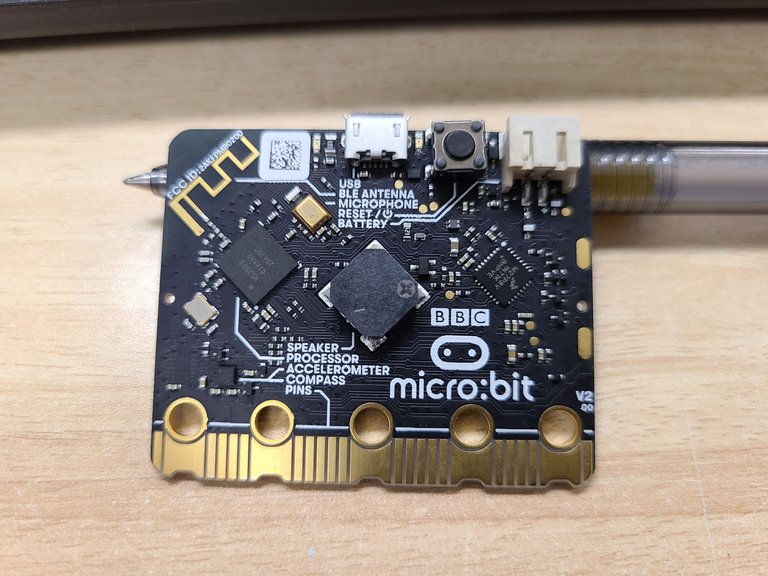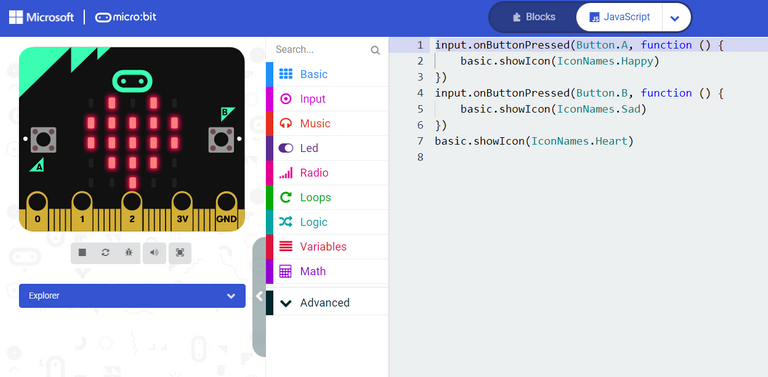BBC micro:bit - Easier Than Arduino!

Introducing the BBC micro:bit to children might be one of the easiest ways to teach coding to younger generations. The physical device at their fingertips shows them the outcome of the code they input instantly, allowing for easy reflection. And the drag and drop coding blocks make teaching simple concepts a breeze. The coding platform allows the students to seamlessly switch between block coding and actual JavaScript, which allows students to learn the language while they think they're just playing. The web-based IDE also features pairing with the micro:bit making uploading your sketches to the device super easy! It also features a virtual micro:bit on the website, allowing you to see what the device will do before you send the code to the micro:bit. That is one of the best features I've ever seen!

The front of the micro:bit features 25 red LEDs arranged in a 5*5 grid along with two buttons and a small hole to pick up sounds on the microphone. There is a secret button on the front that not many people know about. On the newer models, the logo itself acts as a touch sensetive button! Along the bottom edge are the various GPIO pins (general purpose input/output) arranged similarly to the PCIe slot on RAM or a graphics card.
The back of the micro:bit is cram packed with several things, a speaker, a bluetooth antenna, microphone, accelerometer and magnetic compass, two ways to power the device and a reset button. It's quite dense in the way it's packed but BBC still left enough room on the board to silkscreen what some of the components do. I've never seen a micro controller that teaches the children what some of the components are directly on the board.


BBC has coded a well designed site that is aimed at educators as well as self-starting students. It is loaded with simple projects for students to do alone and it has a plethora of lesson plans for teachers and educators so that they can teach the children coding in a structured setting without having to whip up a lesson plan from scratch.
A project is usually designed to be a simple task that can easily be built upon to allow students to easily improve on the end result. For example, a beating heart project ends with a pulsing heart every 1 second. The suggested improvement for students is to hit a specific beats per minute, BPM, say a 72 BPM heartbeat. Students will then have to do a bit of math in order to figure out the proper delays needed to get a more realistic "heart beat." The more attentive students may even notice that to make it really realistic that one beat should have a shorter delay than the other, to give it that traditional ba-dump heartbeat.

For my super-basic test code I set up the micro:bit to show a heart upon startup. When the A or left button is pressed a happy face replaces the heart. When B is pressed, a frowny face appears. It quite literally took me 30 seconds to whip this up which shows just how fast someone can learn to operate these things. I am by no means a coder and would definitely benefit from sitting down and learning a few projects on this device.

And that benefit would come from learning how to do the actual code writing. Drag and drop teaches you how the order of operation works rather well, but it doesn't really teach you to code. At least the way I think about coding, a person typing furiously away at a keyboard, hunting for errors, or even worse, shocked that it works and they don't know why.

Overall I am quite impressed at how the BBC micro:bit is laid out and I think it will have a great impact on our students that are beginning to learn how to code.

Find my artwork for sale exclusively on NFTShowroom.com
Find my photographs of Nunavut scenery and Wildlife on Lensy.io
Follow me on twitter here: Hive Related Account / Photography and Art Account
I am also on Instagram: But only Photography and Art
More art on DeviantArt at: Ice-O-Lated
Hive Divider provided by thepeakstudio

Congratulations @lacking! You received a personal badge!
You can view your badges on your board and compare yourself to others in the Ranking
Check out the last post from @hivebuzz:
Support the HiveBuzz project. Vote for our proposal!
Dear @lacking,
Your support for our proposal has been much appreciated but it will end in a few days!
Do you mind renewing your vote to our proposal for 2022 so our team can continue its work!
You can do it on Peakd, ecency, Hive.blog or using HiveSigner.
https://peakd.com/me/proposals/199
We wish you a Merry Christmas and a Happy New Year!
Wow, didn't know proposal votes expired thanks for the reminder. (Yes I know you're a bot)
Thank you for your support @lacking 🍻